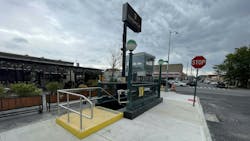MTA releases updated Climate Resiliency Roadmap aiming to reduce impacts of extreme weather
The Metropolitan Transportation Authority (MTA) has updated its Climate Resilience Roadmap on the 13th anniversary of Superstorm Sandy, showcasing its top priorities in extreme weather impact mitigation and the ways climate change can affect transit infrastructure across the system. The update outlines the steps the agency has taken since the release of its last report in April of 2024, including more than $1.5 billion in funding to protect the subway system from flooding and Metro-North Railroad’s Hudson Line from storm surge and sea level rise that were secured as part of the 2025-2029 Capital Plan.
“Transit is the antidote to climate change, but the system can’t work well if it’s constantly getting pounded by severe storms and torrential rain,” said MTA Chair and CEO Janno Lieber. “Working with Gov. [Kathy] Hochul and the city, we must continue to harden our infrastructure to withstand the effects of increasingly extreme weather events.”
The Climate Resilience Roadmap Update explains the need for further partnership with the city, including the identification of 10 priority locations where action is suggested from both the New York City Department of Transportation (NYC DOT) and New York City Department of Environmental Protection (NYCDEP) to manage the impacts of stormwater flooding on neighboring communities and system infrastructure including:
- 4 Av between Union St & 36 St, Brooklyn
- Canal/Lafayette/Centre Streets, Manhattan
- Castleton Depot, Staten Island
- Central Flatbush, Brooklyn
- Central Harlem, Manhattan
- Chelsea/Midtown South, Manhattan
- Cross Island Parkway, Queens
- Grand Av-Newtown, Queens
- Longwood Av, Bronx
- Mott Haven Yard, Bronx
The report also notes nine interagency climate resilience actions between the MTA and New York City, including:
Heavy rain:
Accelerate the pace of capital investments to increase stormwater management capacity, particularly in vulnerable communities adjacent to transit infrastructure.
Maintain sidewalk curbs of sufficient size and catch basins of sufficient capacity to manage intense rain.
Optimize storm sewer networks to send excess stormwater away from overloaded locations adjacent to MTA infrastructure to areas with spare capacity.
Coastal flooding:
- Sustain leadership and future-forward strategy towards coastal resilience in the New York City region.
- Manage the coordinated design and deployment of the city’s flood mitigation measures and deepen coordination with the MTA on emergency operations planning.
- Continue to advance city-led climate data collection and monitoring.
Extreme heat:
- Facilitate the development of thermal energy networks between public and private properties that can utilize waste heat from sources like the subway.
- Encourage new heat recovery and geothermal technologies that pull heat from vulnerable sites like subway stations.
- Provide consistent shade for transit customers by increasing tree canopy.
Since the MTA released its inaugural Climate Resilience Roadmap 18 months ago, progress has been made both in initiating and finishing multiple actions under the roadmap’s 10 goals and related strategies, such as protecting tunnels and subway stations from stormwater penetration. Some of the highlighted strategies for protecting subways included boosting collaboration with city agencies, protecting subway tunnel walls from leaks and installing sidewalk-level protection.
In the September/October 2025 issue, Mass Transit magazine outlined the steps the MTA was taking in those efforts, including long-term and spot grouting programs, and in the examination of sidewalk vent battery protection and in seeking out mechanical replacements for those battery-operated systems that may fail due to water ingress.
“We are taking action to protect our infrastructure and the New Yorkers that rely on it from the impacts of climate change,” said MTA Construction & Development President Jamie Torres-Springer. “This roadmap update highlights the progress we’ve made even in the last eighteen months and lays out the path forward in partnership with the City of New York and other stakeholders.”
The MTA has done preventative work with NYCDEP to clean priority catch basins before heavy rainfall occurs, preventing further flooding. The agency has also cooperated on drainage planning and tunnel and sewer inspections.
